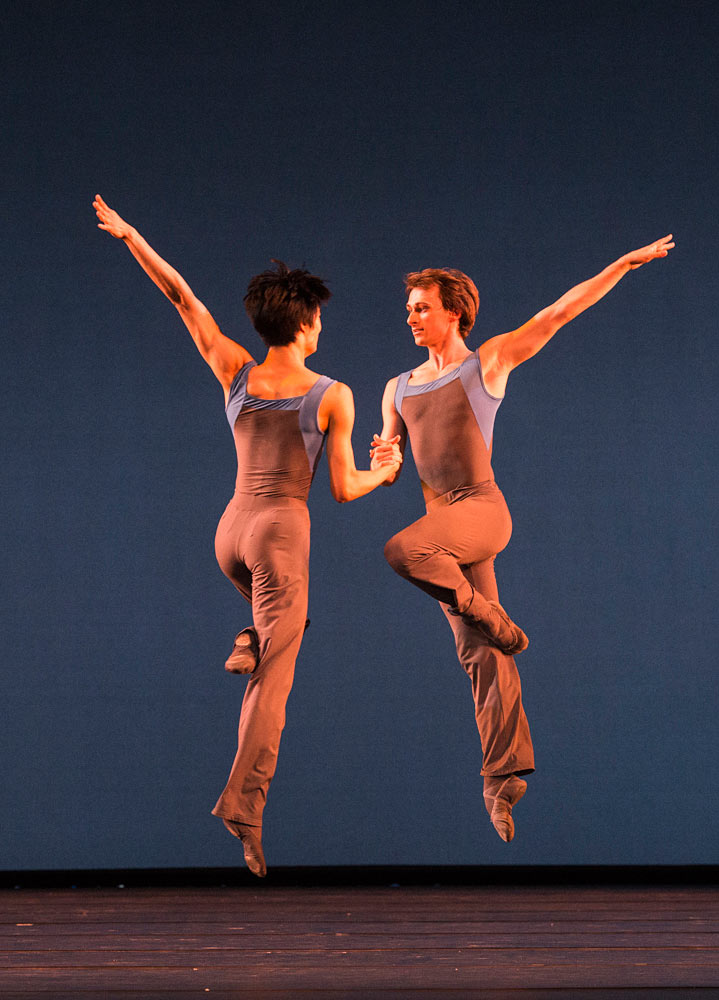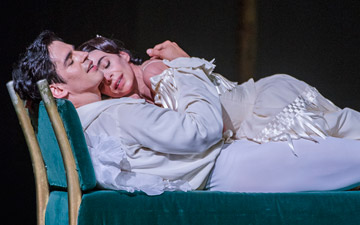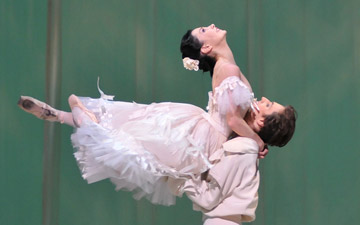
© Foteini Christofilopoulou. (Click image for larger version)
Mariinsky Ballet
The Firebird, Marguerite and Armand, Concerto DSCH
London, Royal Opera House
11 August 2014
www.mariinsky.ru/en
www.roh.org.uk
Gallery of pictures by Foteini Christofilopoulou
All three ballets in the Mariinsky’s last mixed bill of the summer season had connections with the Royal Opera House. Fokine’s Firebird (1910) entered the Royal Ballet’s repertoire in 1954, with Margot Fonteyn coached by Tamara Karsavina in the role she had danced in the Diaghilev era; Ashton’s Marguerite and Armand (1963) was created for Fonteyn and Rudolf Nureyev; Ratmansky’s Concerto DSCH (choreographed for New York City Ballet in 2008) uses the same Shostakovich music as MacMillan’s Concerto (1966, subsequently in the repertoire of both Royal Ballet companies).
The Mariinsky’s version of The Firebird, mounted by Andris Liepa with Isabelle Fokine in 1994, is a curiosity. Its account of Marguerite and Armand (new in July this year) is a travesty. Concerto DSCH (new in July last year) turned out to be the triumph of the triple bill: bad luck for those who’d left early.
The Firebird’s set is based on the original designs by Alexander Golovin and Leon Bakst: a gated garden surmounted by a wall of petrified boyars, with a magical apple tree at the centre. The Firebird – Anastasia Matvienko on the first night – is costumed in a red tutu and feathered headdress much like Fonteyn’s, which dates from a later period. Matvienko seems to have conceived of the avian role as similar to that of Odile. She tries to seduce the hero, Ivan Tsarevich (Andrei Yermakov), instead of fighting for her freedom.
Matvienko has a fleet jump but a flat-footed take-off as she tries to cover ground in the opening scene. She is more impressive lulling the monsters to sleep after their orgy of dancing: here her fluttering arms are mesmerising. The shaggy monsters are an anarchic lot, prone to breaking into show-off solos turns like street dancers in between Mexican-wave formations. The Royal Ballet’s weird submissive creatures seem far more sinister in their obedience to Kostchei’s commands, legs pulsing in unison.
As Ivan Tsarevitch, Yermakov is resolutely unimpressed by monsters. He’s a capable bloke, puzzled by the strange goings-on but prepared to do battle for himself and the beautiful princess with whom he is convincingly smitten. Xenia Dubrovina is indeed lovely, surrounded by blonde-wigged maidens inept at fielding flying apples. Very Russian in their folk-based dances, the girls are probably more balletic than Fokine would have wished.
The last scene, in which the maidens are reunited with the revived stone warriors, is attractive but nothing like as compelling as the Royal Ballet’s magnificent finale in Natalia Goncharova’s designs from 1926 . Yermakov’s stalwart Tsarevitch deserves to inherit the full panoply of an onion-domed city and zillions of courtiers and subjects. Instead, he gets a modest line-up of maidens and boyars waving at a misty backdrop. I miss being blessed by the newly-crowned Tsar as Stravinsky’s bells peal out in rejoicing – one of the great ballet endings.

© Foteini Christofilopoulou. (Click image for larger version)
Ashton created Marguerite and Armand as a vehicle for two great ballet stars. The ballet was based on the particular qualities of Fonteyn and Nureyev, their stage presence and their relationship, as perceived by their adoring public. Recent revivals (banned during Ashton’s lifetime) could only be justified if the leading dancers were truly exceptional. Well, Diana Vishneva and Yuliana Lopatkina are; but Konstantin Zverev is no Nureyev. He should never have been cast, replacing Vladimir Shklyarov at short notice.
Armand’s first entrance should be a sensational one: the position in which he poses, spotlit, is a deliberate reference to Nureyev’s arrogant bare-chested pose in Le Corsaire pas de deux. Poor Zverov lacked any conviction, as he well knew. The ballet is only (just) acceptable if Armand, the object of Marguerite’s passion, appears worthy of such idolatry. Vishneva as Marguerite went into full silent movie mode, emoting towards the audience rather than at him. Unlike Fonteyn, she held back no reserves of dignity to overcome. Indeed, she was so extravagant and so consumptive, expectorating all over the place, that Armand’s father (Andrei Yakovlev) could have been concerned about her sanity as well as her health.

© Foteini Christofilopoulou. (Click image for larger version)
The performance was an object lesson in how a ballet can be betrayed if it is mounted and performed without rigorous supervision. The Balanchine Trust insists on authorised monitoring of all productions: so does the Ashton Trust, so what went wrong? Last minute casting and a ballerina left to fend for herself? Hardly engendering confidence in the production was the sight of ludicrously wigged attendees at Marguerite’s salon, as inelegant as KGB agents in fancy dress. A mistake to present this inept version in a theatre that has seen the real thing.

© Foteini Christofilopoulou. (Click image for larger version)
Ratmansky’s account of Shotakovich’s second piano concerto can have no comparison with MacMillan’s because it is completely different. Made for an American cast, it appears populated by athletes and cheerleaders; danced by Russians, it seems a mock-heroic celebration of Soviet workers in fields and factories, rejoicing at having met their targets. Vladimir Rumyantsev, the pianist for Liszt’s over-orchestrated Piano Sonata in B minor used for Marguerite and Armand, gives Shostakovich’ concerto the infectious enthusiasm Ratmansky’s big cast of youngsters express.

© Foteini Christofilopoulou. (Click image for larger version)
There are two ballerinas: one grown-up with a loyal partner (Viktoria Tereshkina with Andrei Yermakov), the other a tomboy with two rival suitors (Nadezhda Batoeva with Kimin Kim and Filipp Stepin). They are part of a community of brightly dressed companions who come and go in cross-currents of swift-footed dance – a heady mix of classical ballet, folk-dance, horseplay and virtuoso feats. It’s a challenge for Mariinsky corps, unused to such speed and complexity.
The first movement, in which everyone appears, has a motif of a huddle like a bonding session before a team game. As the group disperses, a soloist emerges from the centre: at first, Batoeva in blue, then Tersehkina in celadon green, held high above her supporters’ heads. Incidents occur: a line of orange and fuchsia chorines peels off, leaving one behind in dismay; figures proceed across the back of the stage in silhouette; Batoeva almost knocks herself off balance in a comically lurching solo, then falls over her own feet. She sits slumped with her two suitors, watching the others dash about; then a line of men do the same, sitting waiting like reserves on a bench.

© Foteini Christofilopoulou. (Click image for larger version)
At the start of the slow movement, corps members collapse only to rise again, except for one. They console each other as Tereshkina and Yermakov walk in to start their pas deux, witnessed by three couples. The yearning duet to the piano’s soulful melody is how Marguerite and Armand’s pas de deux should be danced: an exchange of demands, resistance, imploring, regrets, without milking emotion. Lifts are low, like Ashton’s skimming holds, the ballerina’s feet pulsating to the music. Towards the end of the movement, the couple are absorbed into their community, then separated, just as The Firebird’s maidens part their pair of lovers.

© Foteini Christofilopoulou. (Click image for larger version)
A delightful trio follows, as Batoeva swaps partners, shares steps and lifts, claps her hands childishly – another motif, taken up by the corps. Yermakov sweeps through on his own, to be joined by Tereshkina, their melancholy parting forgotten. As excitement mounts, Kimin Kim, who has been competing with Stepin to see who jumps highest, comes to the fore as a Soviet jester, leaping and spinning amidst a group delirium. This is how ecstasy is danced.

















Jann Perry’s review of the Maryinsky was enlightening, and, from this distance,
eminently fair.
I was particularly struck by her reference ti Kimin Kim as well as to see him in
the photograph, if from the back. Hae shik Kim, who has been the Korean juror
for Jackson’s USA IBC some four times and founding dean of the Conservatory of Dance at the Korea National University of Arts (KNUA) mentioned to me in June
that Kim was dancing with the Maryinsky. Kim had won the junior silver at Jackson in 2010. You can well imagine how proud she is to have shepherded her students to such a position.
I agree with Jann. While Marguerite and Armand has been eagerly acquired for La Scala and the Mariinsky, one wonders if companies underestimate how tricky it is to pull off: it’s not merely a “speedy” version of La Dame aux Camellias for a visiting star dancer. So far I’ve yet to see a dancer in the role of Armand not fazed by the reputation of Nureyev or just not up to the difficult choreography Ashton gave Nureyev: the only exception being Nicolas Le Riche (Guillem’s partner at the Royal Ballet revival), who made you believe the ballet had been done for him. (I haven’t seen Murru or the Royal Ballet’s Federico Bonelli though). I was also disappointed to see the weak portrayal of Armand’s father in this production when you know what experienced mime/character artists the Mariinsky has – he’s not a minor cipher, the role is really the third most important character in the ballet. Both Lopatkina and Vishneva were charismatic and eloquent Marguerites but that was it.
Concerto DSCH was lovely – the first and third movements especially brilliant.